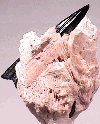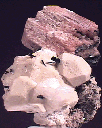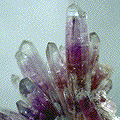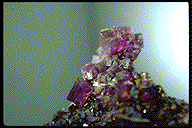MINERAL LOCALITY:
Mont Saint-Hilaire, Quebec, Canada
 |
 |
 |
 |
Serandite |
after Aegirine |
||
 |
 |
 |
 |
Natrolite Crystal |
Serandite |
||
- The Mont Saint-Hilaire site is truly a unique mineral locality. It has produced specimens of over three hundred different minerals with nearly 30 that are new to science and many more yet to be officially recognized as new minerals. The minerals from this site are listed in the comprehensive table of Mont Saint-Hilaire minerals. New minerals (shown in bold in the table) count Mont Saint-Hilaire as their type locality.
-
Mont Saint-Hilaire is a geologically unusual locality. It is called
an "agpaitic pegmatite" which is named for a geologically similar
locality, Agpat, Greenland. There are other agpaitic pegmatites around
the world, but the most famous are the Ilimaussaq
intrusion in southern Greenland, those found in the Kola
Peninsula of Russia, the intrusion at
At least three separate intrusions occurred at Mont Saint-Hilaire. These intrusions incorporated chunks of the host rock or "country rock" into themselves. These assimilations resulted in much of the diversity here. Smaller chunks were melted away and therefore made a change in the chemistry of the intrusion. Larger chunks survived complete melting, but the heat and pressure of the molten magma metamorphosed many of the minerals in these chunks into new minerals which might now contain some of the volatiles of the intrusions. In addition rocks from earlier intrusions would also be assimilated into the next intrusion and so on.
There are other reasons for the great diversity at Mont Saint-Hilaire. A brine present in the country rock at the time of some of the intrusions introduced new elements and volatiles. The pegmatitic stage was also able to have several avenues toward formation including dikes, miarolitic cavities and fracture fillings in brecciated rocks. These isolated environments of pegmatitic formation were all unique depending on chemistry, pore fluid pressure, timing, temperature and the rocks already present. There are many reasons for Mont Saint-Hilaire's great diversity: many are known and many are yet to be explained.
The most renowned mineral from Mont Saint-Hilaire is unquestionably the rare serandite. It has a wonderful salmon color and interesting crystal habit. A favorite among collectors, its only reliable source for good quality specimens is Mont Saint-Hilaire. It is arguable as to who made who famous: did serandite make Mont Saint-Hilaire famous or did Mont Saint-Hilaire make serandite famous. Either way the two are inseparable in the minds of mineral collectors.
There are a host of
The vast majority of minerals at Mont Saint-Hilaire are silicates. However
several rare and new carbonates and oxides are also found here.
Besides serandite there are other note-worthy Mont Saint-Hilaire minerals including
aegirine,
analcime,
synchysite,
leifite,
elpidite,
catapleiite,
villiaumite,
Mont Saint-Hilaire has also supplied the world with facetable material of its rare minerals, some rather large.
In fact several North American gemstone size records are held by Mont Saint-Hilaire gemstones.
These record holders include
analcime,
burbankite,
Much information on this locality was provided by Alkali-Nuts, Mont Saint-Hilaire site, "Fluorescence" by Manuel Robbins and "Gemstones of North America (vol 3)" by Sinkankas.










